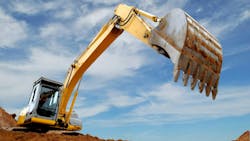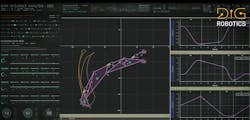When Steel Meets Software: The Intersection of Automation and Hydraulics in Construction
What you'll learn:
- How sensors and software are creating smarter hydraulic systems and enabling automation.
- The benefits which can be achieved with automation of construction equipment and other heavy-duty mobile machinery.
- Trends shaping future hydraulic machinery and uptake of automation in the mobile equipment industry.
During my decades-long journey of working with construction and mining equipment, I’ve watched many transformations. One of the most exciting is the convergence of hydraulics and automation.
The merging of fluid power with intelligent software is exponentially shaping how earth is being moved today, using automated functions, and in some cases, fully autonomous operation of mobile off-highway equipment.
Fluid Power is Getting Smart
Fluid power offers unmatched power density and responsiveness for lifting, digging, and grading. There was a time when hydraulics were regarded as dumb muscle, but that stereotype is obsolete.
Today’s fluid power systems are integrated with software, sensors, and real-time analytics. We can now measure cylinder speed, pressure, pump efficiency, and bucket position, all in real time, with unprecedented accuracy and precision — and then use that data to optimize performance.
We're seeing hydraulics go digital: Valves controlled by algorithms, actuators monitored by sensors, and pressure tuned dynamically based on environmental data. Think of it as upgrading from a mechanical lever to a smart, self-adjusting system that knows exactly when and how hard, fast, and far to move.
All of this is necessary to enable the implementation of semi- and full-autonomous operation.
Automating Hydraulics to Improve Operator Performance
In my current work at Dig Robotics, we like to say we operate at “the intersection of kinematics, 3D scanning and machine learning.” In other words, we combine advanced motion science with real-time 3D sensing to help construction and mining machine operators perform far better than ever before.
Dig’s aftermarket system can be installed on any brand of excavator, guiding the operator in real-time. A LiDAR sensor scans the topography of the job site and the machine’s geometry, and our machine learning (ML) algorithms consume that data to determine optimal hydraulic movements. Our smart algorithms are designed to guide hydraulic motion in real time. We move earth with surgical precision, less fuel, and less human error.
Operator variability has always been a factor in job site productivity and efficiency. I’ve spent decades studying it — sometimes literally sitting on a rock with a stopwatch and clipboard. The difference between a great operator and an average one can be 30% or more. Every operator can become a high performer with the right guidance. Even the best operators can learn to be even more productive and efficient given the proper actionable insights.
Dig Robotics serves as a practical example for this. Our system helps reduce excessive digging, eliminate unnecessary passes, and reduce cycle time. On a single 100-ton excavator, we’ve seen fuel savings of 20% and productivity gains of 10% just by guiding the operator to manage hydraulic motion more intelligently.
Trends Shaping the Future of Hydraulic Machines
There are several trends that will shape future hydraulic system designs to enable more automated and productive off-highway machine performance.
- Digital Hydraulics: The move from mechanical to electronic control is accelerating. We're seeing a shift to closed-loop systems where hydraulics respond instantly to feedback from sensors. This enables smoother, safer, and more efficient operations, and opens the door to predictive maintenance and real-time performance optimization.
- Operator Assistance: Full autonomy may be a long-term goal, but right now the market is demanding smarter machines that help humans work better. Assisted control systems bridge the gap, using automation to guide operators — not replace them. This makes adoption easier, safer, and more scalable across diverse job sites.
- Electro-Hydraulic Hybrids: Electrification isn’t replacing hydraulics but enhancing them. In many cases, electric motors power pumps that feed hydraulic systems. This hybrid approach improves efficiency while retaining the power density of fluid systems, ideal for mid-size and large machines.
- Energy Recovery and Emissions Reduction: Intelligent hydraulics can now capture and reuse energy from deceleration or boom lowering, something we pioneered with early hybrid prototypes. With environmental regulations tightening and fuel prices rising, this will become essential.
What Comes Next for Hydraulics and Automation?
From my perspective, we have entered a golden era of smart construction machinery. However, it’s important to keep in mind that adoption won’t be uniform or linear, as construction sites are dynamic environments. People and machines will co-pilot these systems for years to come.
- In 0-5 years: Widespread adoption of intelligent operator guidance on hydraulic machines is underway, especially in high-production applications like large infrastructure earthmoving, quarrying and mining.
- In 5-10 years: Electro-hydraulic systems will be standard, offering built-in diagnostics, artificial intelligence (AI)-based performance tuning, and plug-and-play autonomy modules.
- In 10-20 years: Fully autonomous excavation will be feasible on select job sites, built on decades of evolution in fluid power control.
Augmentation Today, Autonomy Tomorrow
Some might ask: Why not go straight to fully autonomous, driverless excavators and other machinery? The truth is, full automation in construction is a tougher nut to crack than in more controlled environments like mining, and automating loaders is more challenging than automating hauling units.
I’ve often been asked why mining operations seem to be ahead in adopting robotics. At the risk of oversimplifying, I would say the reason is predictability. In a mine, you might be digging in the same area for 10 or 20 years with few pedestrians or unrelated activities around. That lends itself to automation — in fact, fleets of autonomous haul trucks and drills have been running in mines for years. A busy construction site, on the other hand, is an ever-changing mosaic of people, plans, and surprises. The market just isn’t ready to trust fully autonomous systems in such dynamic environments yet.
So, the industry trend — and our approach at Dig Robotics — is “augmented, not automated,” at least for now. We focus on operator assistance features that make the human-machine team more productive, more efficient and safer, rather than trying to remove the human from the loop entirely.
A Meaningful Transformation for the Off-Highway Equipment Industry
As someone who’s dedicated a lifetime to developing earthmoving machines, I can confidently say: the integration of automation and hydraulics is one of the most exciting transformations our industry has seen.
We’re now building smarter, cleaner, and more consistent machines. It's about making heavy equipment more human-aware, more environmentally responsible, and more aligned with the challenges of our time, such as reducing carbon emissions and looking after our planet. And for me, that’s deeply meaningful work.
This article was written and contributed by Ken Gray, Co-founder and Chief Performance Officer, Dig Robotics.
About the Author

Ken Gray
Co-Founder and Chief Performance Officer, Dig Robotics
Ken is an internationally recognized construction and mining equipment executive perhaps best known as the leader who developed Caterpillar’s first hybrid construction machine. He has over 40 years of international experience developing, manufacturing, marketing, and supporting construction and mining equipment, customers, and dealers.
Ken retired in 2016 after serving as Caterpillar’s first Global Director of Innovation. Previously, he was a Director of Caterpillar’s Excavation Division with worldwide P&L accountability for Large Hydraulic Excavators. Prior to that, he was a Director of CAT’s Building Construction Products Division with global accountability for the Small Hydraulic Excavator product line. His early career progressed through international roles in information technology, engineering, marketing and dealer development.
Ken serves nonprofit boards as Director Emeritus of the Central Illinois Center for the Blind and Visually Impaired, Board Member of the Friends of the Lower Suwannee and Cedar Keys National Wildlife Refuges, Edison Emeritus of the Edison Awards Steering Committee, and member of the Bradley University Mechanical Engineering Alumni Advisory Council.
Ken holds Bachelor of Science and Master of Science degrees in Mechanical Engineering from Bradley University and completed executive development programs at Stanford University, the Institute for Management Development (IMD) in Lausanne, Switzerland, Singularity University and Bradley University.

Leaders relevant to this article:



